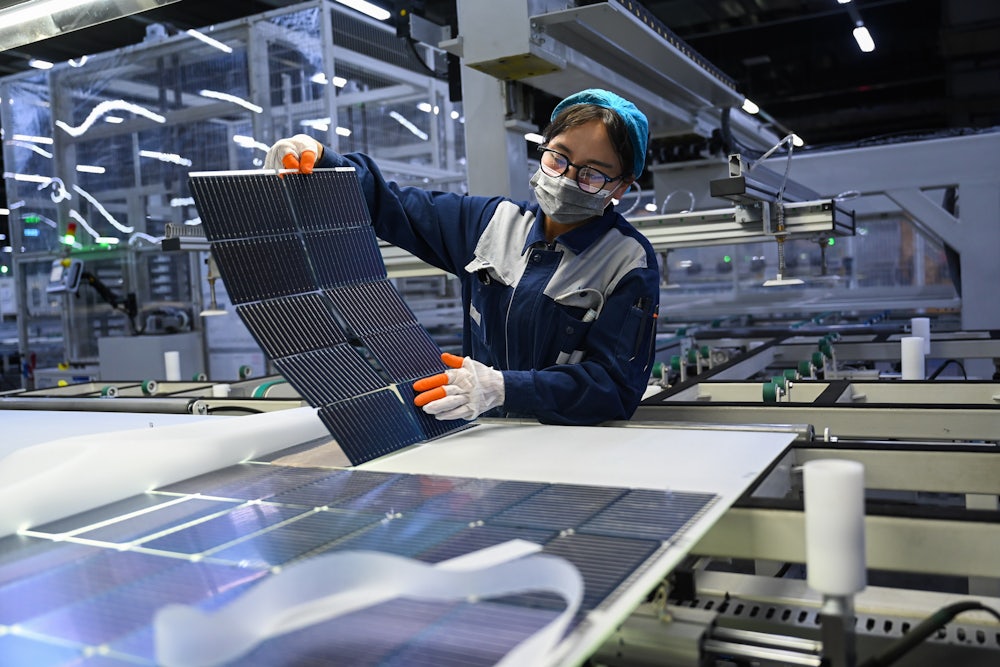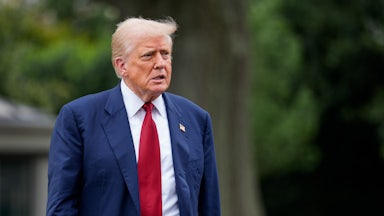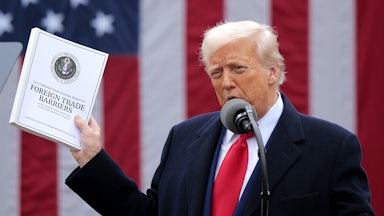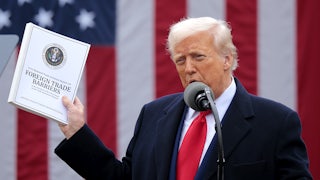Last month, in response to President Donald Trump’s tariff regime, China imposed new export controls on rare earth materials and magnets. Officially, these aren’t bans—but practically, shipments have stopped. This is no small issue: America’s tech leadership, military readiness, and clean energy ambitions all rely on rare earths. This latest disruption exposes a strategic vulnerability—one that we, not China, created through years of strategic neglect. Without immediate action to rebuild our industrial base, spur innovation, and train a skilled workforce, we will lose our economic and military advantage.
We’ve played spectator to this spectacle before. In 2010, after a maritime clash, China halted rare earth exports to Japan, triggering a scramble to build alternative supply chains. Tokyo poured resources into recycling, new mining, and material substitution.
Yet even with deep technical expertise, a stake in Malaysia’s rare earth producer Lynas, and China’s reliance on Japanese industry for advanced rare earth components, Japan could not break free from Chinese supply—and they had substantially more leverage then than the U.S. has now. China relied on imports of Japanese components made from rare earth.
Japan learned a simple truth the hard way: China had built an unassailable lead by producing cheap, high-quality supply at scale. Replicating that capacity would require decades of work and material produced outside China would always cost more.
Still, China’s dominance wasn’t inevitable; it resulted from three decades of dedicated industrial policy and strategic commitment. More than 30 years ago, China imported rare earth processing capabilities developed in the U.S. and Europe. Initially, Chinese firms struggled to match Western efficiency. A trader told me he once saw bits of blue plastic mixed into piles of mineral concentrate—the shovelers had gone too deep and scraped up pieces of the tarp beneath, contaminating the batch.
Through sustained experimentation and incremental refinement, Chinese firms mastered techniques no textbook could teach—the precise dance of acids, heat, and timing that transforms raw rock into high-performance material. They then adapted those techniques to local realities.
For example, they pioneered hydrochloric acid-based extraction methods compatible with low-cost infrastructure like polyvinyl chloride, or PVC, and fiberglass, avoiding the need for expensive stainless steel used in Western setups. And when key international rare earth magnet patents expired, they rapidly scaled magnet production—having already studied or licensed the technologies through government-backed institutes.
The goal wasn’t wealth from the rare earths themselves. After all, the rare earth market is only slightly larger than that of vegan cheese or tonic water; negligible compared to China’s gross domestic product. Instead China saw these materials as foundational to its high-tech ambitions—from EVs and wind turbines, to missile guidance systems and MRIs. So, it invested tremendous time and capital first in domestic supply, then in capturing global flows.
Their material advantage was a boost for Chinese manufacturing—not only was China producing the materials, it was increasingly consuming them. Co-locating processing facilities near end-use customers allowed quicker iteration and tighter feedback, speeding up product design. These are advantages that only proximity can deliver. Before long, China dominated not just rare earth production, but also magnet making and other downstream industries built on the rare earth foundation.
At the same time, the West saw metal making as a dirty industry, ripe for outsourcing. Many rare earth facilities produce a tremendous amount of waste in addition to radioactive elements. Mining was a hard sell to local communities. Many countries legislated heavily to restrict them. It didn’t matter that these resources would power a green society or the next generation of weaponry. We ended up gutting the industry.
The U.S. once spoke the language of mining and metallurgy. Now we can barely understand it. It’s like a child of immigrants who never learned their parents’ language—because it was never passed down.
China, meanwhile, speaks this language fluently—helped by nearly 40 universities specializing in extractive metallurgy and another 40 in mineral processing. In the U.S., that number is zero.
That’s a dependency with consequences: It slows our ability to rebuild capacity and makes it even harder to outprice Chinese production with the exacting specs the industry relies upon. As rare earths are used in highly specialized products—from motors in cars, iPhones, missile actuators, and more—vendors need to be qualified enough to demonstrate that they can continually produce product at high specs. Those still exist nearly all in China.
China can produce a kilogram of dysprosium, the material that turns super strong magnets into heat resistant ones that can go into high-tech goods from robots to EVs, for under $250. Replicating that supply chain elsewhere would cost billions—and still result in higher-cost material. That’s assuming the U.S. can even build the factory: China also dominates the manufacturing of the specialized equipment needed for such infrastructure.
What’s more, even if the U.S. overcomes its technological inexperience and builds the foundations of a domestic supply chain, it will still face China’s vast excess capacity—more than 50 percent in some parts of the processing line. That means China can quickly ramp up production to undercut any newcomer trying to build from scratch. And as the world’s largest rare earth consumer, any producer of size still needs to sell to them.
They’re not just the biggest player in the market—they are the market.
The situation exposes a glaring vulnerability for U.S. production ambitions. MP Materials, America’s only rare earth mine, shipped over 80 percent of its output to a Chinese firm over the past few years. Not by choice—but because the U.S. lacks domestic capacity and expertise to process MP’s output. They themselves have yet to figure out how to make use of most of their production, although they have made steps to diversity.
Now, facing retaliatory Chinese tariffs, MP lost more than 80 percent of its market. Their defiant promise of “reindustrializing the rare earth supply chain” is bold, but without substantial investment, government backing, or a new customer, their future is uncertain at best. The conclusion is hard to avoid: There are no viable alternatives to Chinese rare earths in the near term.
But all is not lost. As our real-estate-steeped president should know, legacy infrastructure can be replaced by smarter design. Our opportunity lies not in replication, but in reinvention. We can build new supply chains that are cleaner, more efficient, and more resilient. This is our Ray Kroc moment.
And we’re not starting from zero. Venture markets are waking up to investment in rare materials. Boston Metal is pioneering cleaner refining techniques that could unlock mineral deposits once considered uneconomic. Noveon Magnetics and Momentum Technologies are enhancing their capacity to make magnets and processing materials domestically—albeit on a small scale. Newlab is bridging U.S. and Middle Eastern capital to back a new generation of mining and materials entrepreneurs.
Still, new technology alone won’t solve the challenge. We need to invest in people. Fewer than 700 students in the U.S. are enrolled in mining-related fields today. That’s not a pipeline—it’s a warning. We need new programs, new professors, and global experts teaching the next generation how to extract, refine, and process the materials that power modern economies.
We must also reduce regulatory duplication and build a federal workforce that understands material flows, mining and industrial policy. That may mean carving out a new agency within the Department of Commerce or Interior—one that can vet credible projects and distinguish industrial strategy from opportunism. Right now, too many companies are mining resources in Washington, D.C., not in the ground. And as the federal government doesn’t understand the market dynamics outside of pockets in the Defense Department and Energy, we’re beholden to companies that are focused on their own pockets rather than the interests of the U.S.
Internationally, we need to think more than money. We must lean into the values that still give the U.S. an edge: long-standing alliances, trust, and transparency. If we want to compete with China abroad, we must be the partner countries choose, not the one they tolerate. That means revitalizing foreign assistance and economic partnerships—making clear that our supply chains are not just secure, but ethical and mutually beneficial. Here, deft diplomacy and trade policy matters, especially with traditional allies.
We need to think about money—and the future. We must align interests with other countries that are taking a larger stake in global investments from the Middle East to Asia, ensuring capital flows to projects that enhance projects globally.
Finally, we must recognize that it’s not China’s fault we depend on its resources—any more than it was Saudi Arabia’s fault the world relied on its oil. That’s the system we built. They have the expertise and we cannot let the pendulum push too far so that it breaks the gears of global commerce that powers the U.S. We must find ways to work together. But if we fail to act soon—to rebuild industrial capacity through education, investment, and strategic policy—we’re not just risking supply shortages. We’re conceding the tools of modern economic and military power to those who never stopped building them.










